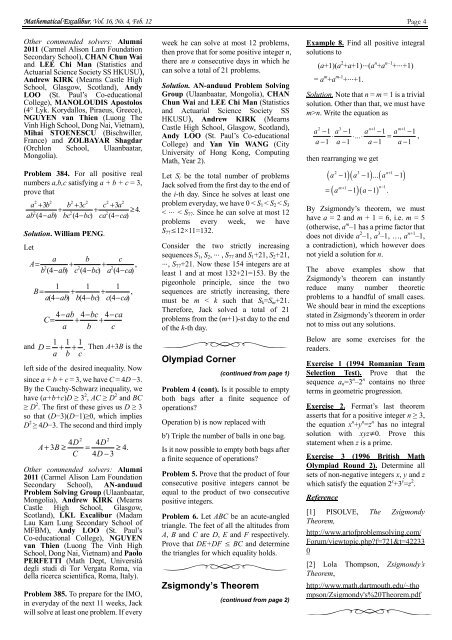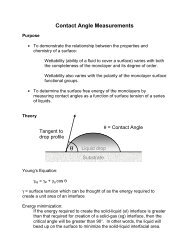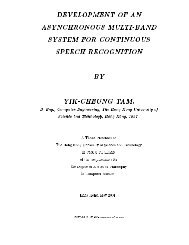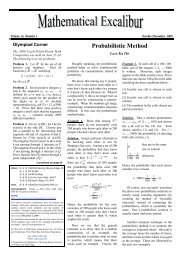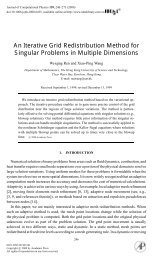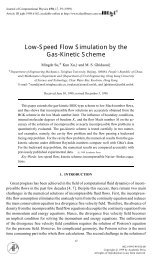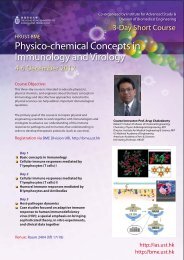Zsigmondy's Theorem - Department of Mathematics - The Hong ...
Zsigmondy's Theorem - Department of Mathematics - The Hong ...
Zsigmondy's Theorem - Department of Mathematics - The Hong ...
You also want an ePaper? Increase the reach of your titles
YUMPU automatically turns print PDFs into web optimized ePapers that Google loves.
Mathematical Excalibur, Vol. 16, No. 4, Feb. 12 Page 4<br />
Other commended solvers: Alumni<br />
2011 (Carmel Alison Lam Foundation<br />
Secondary School), CHAN Chun Wai<br />
and LEE Chi Man (Statistics and<br />
Actuarial Science Society SS HKUSU),<br />
Andrew KIRK (Mearns Castle High<br />
School, Glasgow, Scotland), Andy<br />
LOO (St. Paul’s Co-educational<br />
College), MANOLOUDIS Apostolos<br />
(4° Lyk. Korydallos, Piraeus, Greece),<br />
NGUYEN van Thien (Luong <strong>The</strong><br />
Vinh High School, Dong Nai, Vietnam),<br />
Mihai STOENESCU (Bischwiller,<br />
France) and ZOLBAYAR Shagdar<br />
(Orchlon School, Ulaanbaatar,<br />
Mongolia).<br />
Problem 384. For all positive real<br />
numbers a,b,c satisfying a + b + c = 3,<br />
prove that<br />
2 2 2 2 2 2<br />
a + 3b<br />
b + 3c<br />
c + 3a<br />
+ + ≥4.<br />
2<br />
2<br />
2<br />
ab (4−ab)<br />
bc (4−bc)<br />
ca (4−ca)<br />
Solution. William PENG.<br />
Let<br />
a b c<br />
A=<br />
+ + ,<br />
2<br />
2<br />
2<br />
b (4−ab)<br />
c (4−bc)<br />
a (4−ca)<br />
1 1 1<br />
B=<br />
+ + ,<br />
a(4<br />
−ab)<br />
b(4<br />
−bc)<br />
c(4<br />
−ca)<br />
4−ab<br />
4−bc<br />
4−ca<br />
C=<br />
+ +<br />
a b c<br />
and D 1 1 1<br />
= + .<br />
a b<br />
+ <strong>The</strong>n A+3B is the<br />
c<br />
left side <strong>of</strong> the desired inequality. Now<br />
since a + b + c = 3, we have C = 4D −3.<br />
By the Cauchy-Schwarz inequality, we<br />
have (a+b+c)D ≥ 3 2 , AC ≥ D 2 and BC<br />
≥ D 2 . <strong>The</strong> first <strong>of</strong> these gives us D ≥ 3<br />
so that (D−3)(D−1)≥0, which implies<br />
D 2 ≥ 4D−3. <strong>The</strong> second and third imply<br />
4D<br />
A + 3B<br />
≥<br />
C<br />
2<br />
2<br />
4D<br />
= ≥ 4.<br />
4D<br />
− 3<br />
Other commended solvers: Alumni<br />
2011 (Carmel Alison Lam Foundation<br />
Secondary School), AN-anduud<br />
Problem Solving Group (Ulaanbaatar,<br />
Mongolia), Andrew KIRK (Mearns<br />
Castle High School, Glasgow,<br />
Scotland), LKL Excalibur (Madam<br />
Lau Kam Lung Secondary School <strong>of</strong><br />
MFBM), Andy LOO (St. Paul’s<br />
Co-educational College), NGUYEN<br />
van Thien (Luong <strong>The</strong> Vinh High<br />
School, Dong Nai, Vietnam) and Paolo<br />
PERFETTI (Math Dept, Università<br />
degli studi di Tor Vergata Roma, via<br />
della ricerca scientifica, Roma, Italy).<br />
Problem 385. To prepare for the IMO,<br />
in everyday <strong>of</strong> the next 11 weeks, Jack<br />
will solve at least one problem. If every<br />
week he can solve at most 12 problems,<br />
then prove that for some positive integer n,<br />
there are n consecutive days in which he<br />
can solve a total <strong>of</strong> 21 problems.<br />
Solution. AN-anduud Problem Solving<br />
Group (Ulaanbaatar, Mongolia), CHAN<br />
Chun Wai and LEE Chi Man (Statistics<br />
and Actuarial Science Society SS<br />
HKUSU), Andrew KIRK (Mearns<br />
Castle High School, Glasgow, Scotland),<br />
Andy LOO (St. Paul’s Co-educational<br />
College) and Yan Yin WANG (City<br />
University <strong>of</strong> <strong>Hong</strong> Kong, Computing<br />
Math, Year 2).<br />
Let S i be the total number <strong>of</strong> problems<br />
Jack solved from the first day to the end <strong>of</strong><br />
the i-th day. Since he solves at least one<br />
problem everyday, we have 0 < S 1 < S 2 < S 3<br />
< ⋯ < S 77 . Since he can solve at most 12<br />
problems every week, we have<br />
S 77 ≤12×11=132.<br />
Consider the two strictly increasing<br />
sequences S 1 , S 2 , ⋯ , S 77 and S 1 +21, S 2 +21,<br />
⋯, S 77 +21. Now these 154 integers are at<br />
least 1 and at most 132+21=153. By the<br />
pigeonhole principle, since the two<br />
sequences are strictly increasing, there<br />
must be m < k such that S k =S m +21.<br />
<strong>The</strong>refore, Jack solved a total <strong>of</strong> 21<br />
problems from the (m+1)-st day to the end<br />
<strong>of</strong> the k-th day.<br />
Olympiad Corner<br />
(continued from page 1)<br />
Problem 4 (cont). Is it possible to empty<br />
both bags after a finite sequence <strong>of</strong><br />
operations?<br />
Operation b) is now replaced with<br />
b') Triple the number <strong>of</strong> balls in one bag.<br />
Is it now possible to empty both bags after<br />
a finite sequence <strong>of</strong> operations?<br />
Problem 5. Prove that the product <strong>of</strong> four<br />
consecutive positive integers cannot be<br />
equal to the product <strong>of</strong> two consecutive<br />
positive integers.<br />
Problem 6. Let ABC be an acute-angled<br />
triangle. <strong>The</strong> feet <strong>of</strong> all the altitudes from<br />
A, B and C are D, E and F respectively.<br />
Prove that DE+DF ≤ BC and determine<br />
the triangles for which equality holds.<br />
Zsigmondy’s <strong><strong>The</strong>orem</strong><br />
(continued from page 2)<br />
Example 8. Find all positive integral<br />
solutions to<br />
(a+1)(a 2 +a+1)⋯(a n +a n–1 +⋯+1)<br />
= a m +a m-1 +⋯+1.<br />
Solution. Note that n = m = 1 is a trivial<br />
solution. Other than that, we must have<br />
m>n. Write the equation as<br />
2 3 n+ 1 m+<br />
1<br />
a −1 a −1 a −1<br />
a −1<br />
⋅ ⋅...<br />
⋅ = ,<br />
a−1 a−1 a−1 a−1<br />
then rearranging we get<br />
( )( ) (<br />
2 3 n+<br />
1<br />
a −1 a −1 ... a −1<br />
m+<br />
1<br />
( a )( a )<br />
n−1<br />
= −1 −1 .<br />
By Zsigmondy’s theorem, we must<br />
have a = 2 and m + 1 = 6, i.e. m = 5<br />
(otherwise, a m –1 has a prime factor that<br />
does not divide a 2 –1, a 3 –1, …, a n+1 –1,<br />
a contradiction), which however does<br />
not yield a solution for n.<br />
<strong>The</strong> above examples show that<br />
Zsigmondy’s theorem can instantly<br />
reduce many number theoretic<br />
problems to a handful <strong>of</strong> small cases.<br />
We should bear in mind the exceptions<br />
stated in Zsigmondy’s theorem in order<br />
not to miss out any solutions.<br />
Below are some exercises for the<br />
readers.<br />
Exercise 1 (1994 Romanian Team<br />
Selection Test). Prove that the<br />
sequence a n =3 n –2 n contains no three<br />
terms in geometric progression.<br />
Exercise 2. Fermat’s last theorem<br />
asserts that for a positive integer n ≥ 3,<br />
the equation x n +y n =z n has no integral<br />
solution with xyz≠0. Prove this<br />
statement when z is a prime.<br />
Exercise 3 (1996 British Math<br />
Olympiad Round 2). Determine all<br />
sets <strong>of</strong> non-negative integers x, y and z<br />
which satisfy the equation 2 x +3 y =z 2 .<br />
Reference<br />
[1] PISOLVE, <strong>The</strong> Zsigmondy<br />
<strong><strong>The</strong>orem</strong>,<br />
http://www.art<strong>of</strong>problemsolving.com/<br />
Forum/viewtopic.php?f=721&t=42233<br />
0<br />
[2] Lola Thompson, Zsigmondy’s<br />
<strong><strong>The</strong>orem</strong>,<br />
http://www.math.dartmouth.edu/~tho<br />
mpson/<strong>Zsigmondy's</strong>%20<strong><strong>The</strong>orem</strong>.pdf<br />
)


